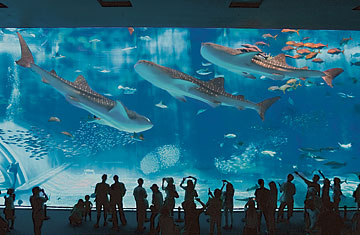
Big blue: The huge Kuroshio Sea tank features marine life found off Okinawa
Best Fish Tank
Motobu, Okinawa, Japan
Churaumi means "beautiful ocean" in the okinawan dialect, and that's exactly what you'll find contained in a 35-m-wide, 27-m-long and 10-m-deep tank at the Okinawa Churaumi Aquarium, an approximately two-hour drive from the subtropical Japanese island's capital, Naha. Called the Kuroshio Sea tank, the display is part of a complex of halls that recreate life at different levels of the ocean, and contains 7,500 cubic meters of water, roughly equivalent to three Olympic-sized swimming pools. Holding back all that water is the world's largest acrylic window, and the sight is breathtaking. Though the pane is 60 centimeters thick, it appears as if nothing separates visitors from the gracefully gliding marine life on the other side.
Unusually, the Kuroshio Sea display isn't filled with a showy collection of fish hauled from all over the planet. Instead, all the creatures inside can be found in local waters, including the world's largest fish, the whale shark, and the largest ray, the manta. About 70 species can be spotted in total, swimming about in water pumped from 300 meters offshore. Millions of spectators every year come to stand mesmerized before this blue world. "Everyone is moved by the experience seeing animals they've never seen before," says aquarium director Senzo Uchida. "There must be something about the ocean that speaks to our hearts."
The tank's size was essential for Uchida's ambition, which was to hold several whale sharks at once as part of a captive-breeding program, scheduled to commence soon. Churaumi already manages large beds of reproducing corals — a project that helps to replenish natural reefs in Okinawa's waters. But the whale-shark program is an entirely different magnitude of challenge. "We still don't know much about them," Uchida says. "There are many things we can learn only by observing them in captivity."